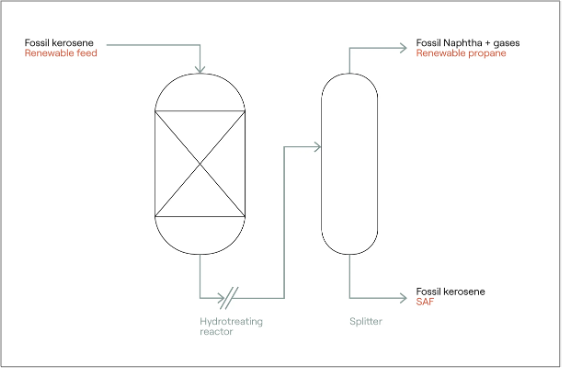Co-processing promises a cost-efficient SAF pathway – but not all refineries face equal costs

By Maria J. L. Perez, Senior Product Line Director for Clean Fuels & Chemicals Catalysts and Milica Folic, Product Line Director for Clean Fuels & Chemicals Technology, Topsoe
Special to The Digest
By introducing renewable feedstocks directly into existing diesel hydrotreaters, refineries can produce a combination of renewable and fossil diesel, reducing CO2 emissions originating from fossil-based feedstocks. But what are the main benefits of co-processing in kerosene hydrotreaters for SAF production, the costs involved in co-processing, and what are the factors that influence these costs?
Benefits of co-processing in kerosene hydrotreaters
Co-processing in kerosene hydrotreaters offers several advantages for SAF production. Firstly, it provides the easiest way to start producing SAF, as it can be implemented without major modifications to existing units. This low capital expenditure (CAPEX) solution allows refineries to begin producing SAF quickly and efficiently. Additionally, co-processing offers flexibility in choosing the starting point, with renewable feedstock levels reaching up to 5% (the level currently permitted by ASTM). By integrating co-processing into the refinery, businesses can diversify their operations and create a more sustainable and profitable business model.
Limited equipment modifications
Co-processing of less than 5% renewable feedstocks in your kerosene unit can, as far as process compatibility is concerned, be done easily without modifications (aside from changing the catalyst) or with minor modifications depending on the existing unit configuration and design conditions However, it is recommended to install a selective renewable grading and hydrodeoxygenation (HDO) catalyst to maximize yield and contaminant pick-up capacity. Nevertheless, this solution still offers a faster and lower CAPEX alternative compared to building a new grassroots unit.
Cost implications of converting a refinery to SAF co-processing
The cost of converting a conventional refinery into an SAF facility through co-processing can vary significantly depending on several factors. These factors include excess hydrogen availability, current refinery infrastructure, logistics for acquiring and storing renewable fuels, refinery layout, and utilization rate.
For example, a conventional refinery with a kerosene hydrotreater unit operating at moderate pressure, sufficient catalyst volume, and excess hydrogen supply may require only a change of catalysts (hydrodeoxygenation and dewaxing catalysts) for co-processing up to 5% volume. In this scenario, the production of SAF can be achieved with minor CAPEX investment and no revamp of the kerosene hydrotreater.
However, refineries with limitations in the operations of their kerosene hydrotreaters or insufficient hydrogen supply may need to evaluate revamping hydrogen units or hydroprocessing units to ensure sufficient hydrogen flow and reactor volumes for SAF production through co-processing.
As each refinery is unique, it is challenging to provide a typical cost without specific details about a particular refinery’s circumstances. A thorough evaluation of the refinery’s capabilities and requirements is necessary to determine the cost of converting it into an SAF facility.

Getting an accurate cost assessment
Co-processing in kerosene hydrotreaters offers a cost-effective pathway for refineries to transition or diversify into renewable refineries and to produce SAF. By leveraging existing infrastructure and making minor modifications, refineries can start producing SAF quickly and efficiently.
But as noted, the cost implications of converting a refinery to co-processing depend on various factors. A detailed evaluation is necessary to determine the specific cost of conversion for each refinery. As a knowledge partner to our customers that goes beyond merely providing technology and catalyst solutions, Topsoe can provide a full assessment of refinery characteristics and how best and most cost-effectively they can diversify into renewables.
We have decades of experience optimizing traditional refinery businesses and have already enabled several customers to produce SAF via co-processing. In Europe and Asia, we are particularly excited for co-processing’s potential, and our experience allows us to be a technology and solutions supplier and a knowledge partner for our customers.
Category: Fuels














